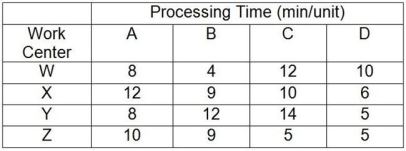Table 5.2
A company makes four products that have the following characteristics: Product A sells for $75 but needs $20 of materials and $20 of labor to produce; Product B sells for $90 but needs $45 of materials and $20 of labor to produce; Product C sells for $110 but needs $50 of materials and $30 of labor to produce; Product D sells for $135 but needs $75 of materials and $40 of labor to produce. The processing requirements for each product on each of the four machines are shown in the table.

Work centers W, X, Y, and Z are available for 40 hours per week and have no setup time when switching between products. Market demand is 50 As, 60 Bs, 70 Cs, and 80 Ds per week. In the questions that follow, the traditional method refers to maximizing the contribution margin per unit for each product, and the bottleneck method refers to maximizing the contribution margin per minute at the bottleneck for each product.
-Use the information in Table 5.2. Using the traditional method, which product should be scheduled first?
Definitions:
Net Capital Outflow
The difference between a country's savings and its domestic investments, representing the amount of money that flows out of the country to invest abroad minus the amount of money that flows into the country from foreign investors.
Net Exports
The value of a country's total exports minus its total imports; a measure of a nation's foreign trade balance.
Net Capital Outflow
The financial discrepancy between home country residents' investments in foreign lands and foreign investors' stakes in domestic assets.
U.S. Net Capital Outflow
The difference between the purchase of foreign assets by residents of the United States and the purchase of U.S. assets by foreigners.
Q11: Champion Cooling Company uses a kanban system
Q25: Use Scenario 6.1 to determine the total
Q41: Lean systems do not need stable master
Q47: Your team has been asked to develop
Q48: Regarding control charts, changing from two-sigma limits
Q65: Sleep Tight Motel has the opportunity to
Q96: Options for achieving line-flow layouts in a
Q120: Use the information from Table 5.7 and
Q133: A good risk management plan will contain
Q171: A metal-cutting operation has a target value